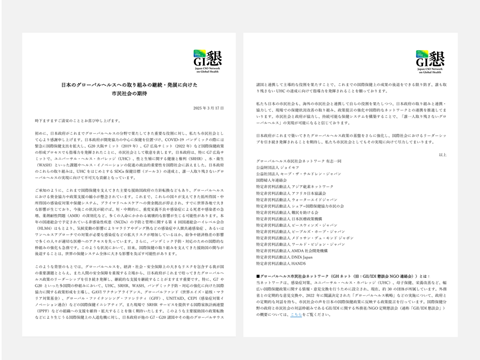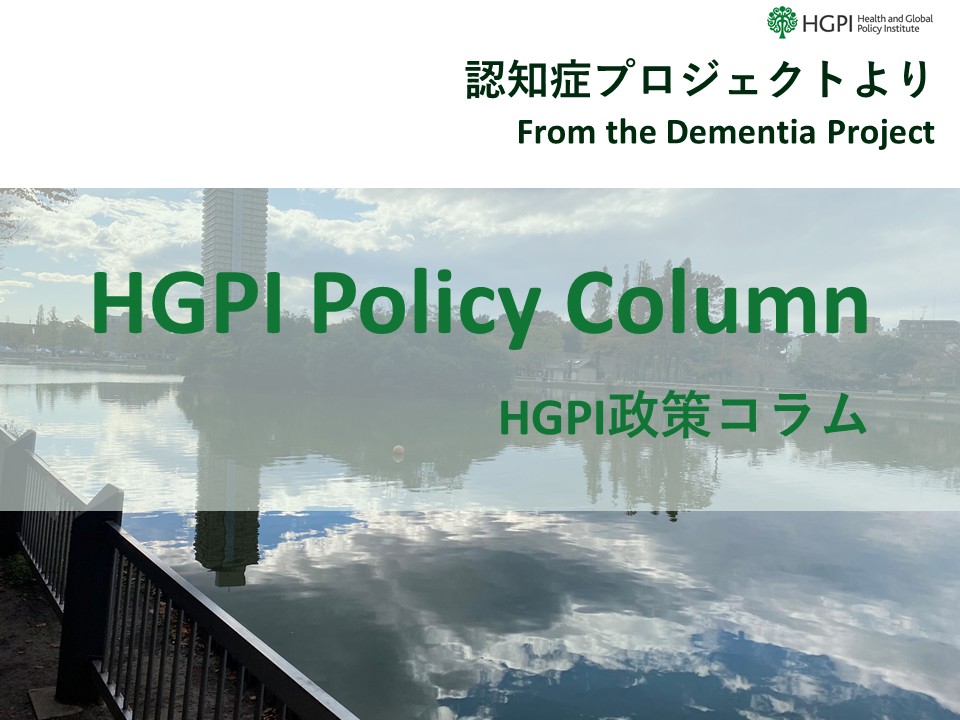[HGPI Policy Column] (No.58) — From the Global Health Strategy Project — “Toward Fair Health Systems: The Power of Data in Advancing UHC and Supporting Health Financing”
date : 4/23/2025
Tags: Global Health, Global Health Strategy, HGPI Policy Column
![[HGPI Policy Column] (No.58) — From the Global Health Strategy Project — “Toward Fair Health Systems: The Power of Data in Advancing UHC and Supporting Health Financing”](https://hgpi.org/en/wp-content/uploads/sites/2/HGPI_UHC_Financing_Data.jpg)
<POINTS>
- Universal Health Coverage (UHC) is not only about ensuring access to health care, but also serves as a foundation for social stability and resilience.
- To visualize each country’s progress toward UHC, reliable data that accurately captures health financing is indispensable.
- International organizations such as WHO, the World Bank, OECD, and IHME each offer databases with distinct perspectives and strengths.
- Understanding and utilizing the characteristics of each database according to purpose is essential for effective policymaking and international comparison.
Introduction
In recent years, the field of global health has seen a growing international focus on strengthening national health systems, particularly through the advancement of Universal Health Coverage (UHC), often catalyzed by responses to infectious disease outbreaks. The G7 and G20, in particular, have increasingly positioned health as a central topic on their agendas, alongside more traditional themes such as the economy, security, and climate change.
In parallel with these international developments, Japan has also advanced domestic policies centered around UHC. In its Vision for Global Health released in 2024, the Ministry of Health, Labour and Welfare emphasized UHC as a pillar of both Japan’s global contributions and the sustainability of its domestic health system. In 2025, the establishment of a UHC Knowledge Hub is planned, aiming to foster capacity-building and knowledge-sharing—especially in collaboration with the World Health Organization (WHO) and the World Bank—to support health financing systems in low- and middle-income countries.
At the Hiroshima G7 Summit, where Japan demonstrated leadership as host nation, key initiatives were proposed to ensure the sustainability of UHC, including financial strategies and public-private partnerships for innovation and resource mobilization. These proposals were later reflected in subsequent international policy documents. Furthermore, Japan’s domestic strategies—such as the Future Vision for a Healthy and Active Society and the third phase of the Healthcare Policy—outline the goal of achieving stronger, fairer, and more sustainable UHC as a means of realizing human security through the reinforcement of health systems across countries.
However, a concerning global trend has emerged: major donor countries are increasingly facing fiscal constraints and turning inward, raising fears of reduced international health funding. This poses a risk to efforts supporting infectious disease responses and primary health care in low- and middle-income countries and could undermine the progress made toward UHC through the Sustainable Development Goals (SDGs). The COVID-19 pandemic exposed the fragility of health financing structures, which many countries are now being urged to rebuild.
Amid these challenges, United Nations and international organizations such as the World Bank, WHO, and the Organisation for Economic Co-operation and Development (OECD) continue to play vital roles in monitoring UHC indicators, developing national financing strategies, and providing technical support. Health financing, in particular, remains a critical component for realizing UHC. It is essential for designing systems that reduce individuals’ financial risks and ensure access to needed health services for all.
This policy column revisits the importance of health financing in achieving UHC and introduces several international databases that help monitor and assess its progress. It provides an overview of their respective features, strengths, and limitations. These databases serve as powerful tools for policymakers and researchers to evaluate the sustainability and effectiveness of health systems and act as crucial starting points for global dialogue on UHC.
The Three Pillars of Health Financing
Health financing consists of the following three core functions:
- Revenue Collection: The process of gathering financial resources for health, such as through taxes or social insurance contributions.
- Pooling: A mechanism for sharing the collected resources to spread financial risk across individuals and populations.
- Purchasing: The allocation of funds to health services—deciding how, what, and to whom payments for health services are made.
When these mechanisms are weak, individuals with lower incomes may be unable to access necessary healthcare, or households may face financial ruin due to out-of-pocket payments. Therefore, reliable data that can visualize and assess the design and functioning of health financing systems is essential in the pursuit of UHC.
Comparison of Health Financing Databases
Below is an overview of key health financing databases provided by major international organizations, summarizing their respective features, strengths, and limitations.
World Health Organization (WHO)
- Global Health Expenditure Database (GHED)
- Covers more than 190 countries, offering a wide range of indicators on national health financing systems, sources of funds, service providers, and disease-specific spending.
- Aligned with the SHA2011 framework, enabling international comparability.
- Strengths: Comprehensive coverage, transparency, technical support through tools such as HAPT and JHAQ, quality control, and regular reporting (e.g., Global Health Expenditure Report).
- Limitations: Approximately two-year delay in updates; few countries report complete data across all classifications; data quality varies significantly by country.
World Bank
- World Development Indicators (WDI)
- A comprehensive database covering various aspects of development. Key health financing indicators are reprinted from WHO’s GHED.
- Government Health Budgets and Spending Database
- Focuses on government health expenditure (excluding social health insurance), mainly in low-income and lower-middle-income countries.
- Health, Nutrition and Population (HNP) Statistics
- Offers over 250 indicators related to health, nutrition, and population, with country-level visualizations.
- Strengths: Rich visualization features, cross-sectoral coverage, frequent updates (WDI is updated quarterly), useful for long-term trend analysis.
- Limitations: Primarily secondary data; limited granularity; lacks detailed information on private healthcare and the structure of funding sources.
Organisation for Economic Co-operation and Development (OECD)
- OECD Health Expenditure and Financing Database
- Covers 38 OECD member countries with standardized data collection using the Joint Health Accounts Questionnaire (JHAQ).
- Includes indicators such as government spending, private expenditure, out-of-pocket payments, and breakdowns by type of insurance.
- Strengths: High comparability; indicators well-suited for policy analysis; well-established reporting systems.
- Limitations: Limited to high-income countries; constrained granularity in regional and private sector breakdowns.
Institute for Health Metrics and Evaluation (IHME), University of Washington
- Development Assistance for Health (DAH) Database
- A database focused on expenditure data related to external assistance. Enables analysis and future projections based on estimation models.
- Strengths: Clarifies the structure of global health aid; provides predictive models (to 2030 and 2040); offers an independent perspective.
- Limitations: Heavy reliance on estimates; challenges in consistency due to integration of multiple data sources.
Global Fund
- Data Explorer
- A grant database specializing in HIV, tuberculosis, and malaria. Visualizes country-specific program progress and funding allocations.
- Strengths: Results-based financing; open access to grant data; frequent updates.
- Limitations: Limited information on domestic financing; difficult to grasp the overall picture due to the project-based nature of data.
Global Financing Facility (GFF)
- GFF Data Portal
- Health budget and expenditure data related to maternal and child health, youth, and reproductive health. Includes a resource mapping function.
- Strengths: Six financial indicators that support reform efforts; strong visualization and country-level analysis; alignment with the SDGs.
- Limitations: Limited to GFF-supported countries; much of the data is not publicly available; difficult to use for international comparisons.
UHC2030(WHO, World Bank, OECD Joint Initiative)
- UHC Data Portal
- Provides an integrated evaluation combining quantitative (finance, services) and qualitative (governance, civil society engagement) data.
- Strengths: Dashboard format; includes perspectives from the Civil Society Engagement Mechanism (CSEM); effective for evaluating policy governance.
- Limitations: Relies on secondary data; variability in institutional assessments; limited detail for financial tracking.
Toward Effective Use: Who Should Choose What and Why
These databases should be selected based on the user’s role and objective:
- National policymakers can refer to WHO’s GHED and the World Bank’s HNP statistics for long-term trends and international comparisons, while using OECD data to analyze specific expenditure structures.
- Researchers may explore thematic investment patterns through sources like DAH and GFF, and supplement their institutional analyses using UHC2030.
- NGOs and civil society organizations can utilize the CSEM reports from UHC2030 to assess accountability, including “voices from the ground.”
Conclusion
Achieving Universal Health Coverage (UHC) is not only about expanding access to health services—it is deeply tied to the challenge of ensuring financial sustainability. In particular, issues such as reducing aid dependency and mobilizing domestic resources have become central to future health system design in many countries. To achieve UHC, the principle that “all people should receive the health services they need without suffering financial hardship” must be consistently reflected in system design, budget allocation, service delivery, and governance.
To address these challenges, robust and accurate data that captures the reality of health financing and UHC is fundamental to policy development and system operation. Without appropriate data, it is impossible to identify service gaps, determine who is bearing the greatest financial burden, track how health expenditures are distributed, or evaluate their outcomes. Utilizing these databases goes beyond monitoring; it serves as a foundation for evidence-based policy dialogue. For example, encouraging collaboration between ministries of health and finance requires quantitative data to demonstrate public financial management (PFM) efficiency and program performance. Health financing data can provide legitimacy and rationale for prioritization in policymaking. Furthermore, organizing and visualizing this data in a way that is internationally comparable contributes to global benchmarking and mutual learning.
In recent years, increasing emphasis has been placed on innovative financing, domestic resource mobilization, and partnerships through technical support and public-private collaboration—all of which require reliable data. If health financing strengthening is the pillar supporting sustainable UHC, then building and utilizing health financing data is its backbone. From the perspectives of “transparency” and “public good,” efforts are also underway to create open platforms through international and national collaboration—an important trend in advancing UHC.
Amid complex and overlapping challenges—such as economic pressure, aging populations, climate change, and shifting disease patterns—making the most of limited resources and protecting the health and well-being of future generations has never been more important. In this context, health financing databases serve as a compass to guide policy design, coordination, and evaluation. Moving forward, discussions around UHC will increasingly require not only a governance lens—“who makes decisions, how, and based on what”—but also a data justice perspective: “what data is used, for whom, and in what way.”
To translate the goal of UHC into real-world systems, it is essential to develop and utilize data as a “common language” that enables dialogue among diverse stakeholders. To this end, we must go beyond simply using existing data—we need institutional support, capacity building, and partnership development across the entire cycle of data collection, management, sharing, and use. To turn UHC into a “sustainable reality,” we must reevaluate the significance of health financing data and strategically position it in the center of health system reform.
References
- UHC2030. (n.d.). UHC Data Portal. Retrieved from https://www.uhc2030.org/what-we-do/knowledge-and-networks/uhc-data-portal/
- Global Financing Facility. (n.d.). GFF Data Portal. Retrieved from https://data.gffportal.org/
- Global Fund. (n.d.). Data Explorer. Retrieved from https://data.theglobalfund.org/
- Institute for Health Metrics and Evaluation (IHME). (2024). Development Assistance for Health Database 1990-2023. Retrieved from https://ghdx.healthdata.org/record/ihme-data/development-assistance-health-database-1990-2023
- Organisation for Economic Co-operation and Development (OECD). (n.d.). Health Expenditure and Financing Database. Retrieved from https://data-explorer.oecd.org/vis?lc=en&df%5bds%5d=dsDisseminateFinalDMZ&df%5bid%5d=DSD_SHA%40DF_SHA&df%5bag%5d=OECD.ELS.HD&dq=.A.EXP_HEALTH.PT_B1GQ._T.._T.._T…&pd=2015%2C&to%5bTIME_PERIOD%5d=false&vw=ov
- World Bank. (n.d.). World Development Indicators. Retrieved from https://datatopics.worldbank.org/world-development-indicators/
- World Bank. (n.d.). Government Health Budgets and Spending Database. Retrieved from https://datacatalog.worldbank.org/search/dataset/0064552
- World Bank. (n.d.). Health, Nutrition and Population (HNP) Statistics. Retrieved from https://datatopics.worldbank.org/health/home
- World Health Organization. (n.d.). Global Health Expenditure Database (GHED). Retrieved from https://apps.who.int/nha/database/Home/Index/en/
- Inaoka, E. (2024). Strengthening the Financial Sustainability of Disease Programs. Friends of the Global Fund, Japan (FGFJ) Issue Brief. Retrieved from https://jcie.org/analysis/books-reports/fgfj-strengthening-financial-sustainability-disease-programs-brief/
Authors
Swati Mittal (Program Specialist, Health and Global Policy Institute (HGPI))
Gail Co (Program Specialist, Health and Global Policy Institute (HGPI))
Joji Sugawara (Vice President, Health and Global Policy Institute (HGPI))
Top Research & Recommendations Posts
- [Research Report] Perceptions, Knowledge, Actions and Perspectives of Healthcare Organizations in Japan in Relation to Climate Change and Health: A Cross-Sectional Study (November 13, 2025)
- [Research Report] The 2025 Public Opinion Survey on Healthcare in Japan (March 17, 2025)
- [Policy Recommendations] Mental Health Project: Recommendations on Three Issues in the Area of Mental Health (July 4, 2025)
- [Research Report] The 2023 Public Opinion Survey on Satisfaction in Healthcare in Japan and Healthcare Applications of Generative AI (January 11, 2024)
- [Policy Recommendations] Developing a National Health and Climate Strategy for Japan (June 26, 2024)
- [Policy Recommendations] Reshaping Japan’s Immunization Policy for Life Course Coverage and Vaccine Equity: Challenges and Prospects for an Era of Prevention and Health Promotion (April 25, 2025)
- [Policy Recommendations] Recommendations on Strategic Investments in Policies for Brain Health to Revitalize Japan: Hopes for the New Administration (December 1, 2025)
- [Announcement] HGPI Endorses the “Belém Health Action Plan” (November 14, 2025)
- [Announcement] HGPI Joins Global Green and Healthy Hospitals (August 1, 2023)
- [Research Report] AMR Policy Update #2: WHO’s First Report on Fungal Infection—Bridging the Gap Between Clinical Practice and R&D
Featured Posts
-
2025-12-09
[Event Report] Special Seminar “Rising to New Challenges in Health Sciences for Future Society: Novel Developments in the Field of Epilepsy in Japan and Globally” Belgium Pavilion Special Seminar, World Expo 2025 Osaka, Kansai (September 18, 2025)
![[Event Report] Special Seminar “Rising to New Challenges in Health Sciences for Future Society: Novel Developments in the Field of Epilepsy in Japan and Globally” Belgium Pavilion Special Seminar, World Expo 2025 Osaka, Kansai (September 18, 2025)](https://hgpi.org/en/wp-content/uploads/sites/2/HGPI_20250805_mental-health-expo-eyechatch.png)
-
2025-12-11
[Event Report] Core Components of Universal Health Coverage (UHC): Achieving “Healthcare Without Financial Hardship” in Asia-Pacific and Japan (December 5, 2025)
![[Event Report] Core Components of Universal Health Coverage (UHC): Achieving “Healthcare Without Financial Hardship” in Asia-Pacific and Japan (December 5, 2025)](https://hgpi.org/en/wp-content/uploads/sites/2/HGPI_20251210_Core-Components-of-Universal-Health-CoverageUHC-top.jpg)
-
2025-12-12
[Registration Open] Meaningful Involvement Promotion Project Urgent Symposium “The New Takaichi Administration and Central Social Insurance Medical Council Reform – Ensuring Patients’ Voices are Heard” (January 22, 2026)
![[Registration Open] Meaningful Involvement Promotion Project Urgent Symposium “The New Takaichi Administration and Central Social Insurance Medical Council Reform – Ensuring Patients’ Voices are Heard” (January 22, 2026)](https://hgpi.org/en/wp-content/uploads/sites/2/HGPI_20251208_urgent-symposium-1.png)
-
2025-12-12
[Registration Open] (Webinar) The 140th HGPI Seminar “Early Detection to Reduce COPD Disease Burden: Connecting Clinical Frontiers with Health Policy” (January 27, 2026)
![[Registration Open] (Webinar) The 140th HGPI Seminar “Early Detection to Reduce COPD Disease Burden: Connecting Clinical Frontiers with Health Policy” (January 27, 2026)](https://hgpi.org/en/wp-content/uploads/sites/2/hs140-top.png)
-
2025-12-16
[Discussion Points] Policy Dialogue “Considering Comprehensive Genomic Profiling from the Perspective of Patient Access: Utilizing the Medical Service Fee Reimbursement System and the Mixed Medical Services Program to Meet the Needs of Today” (November 28, 2025)
![[Discussion Points] Policy Dialogue “Considering Comprehensive Genomic Profiling from the Perspective of Patient Access: Utilizing the Medical Service Fee Reimbursement System and the Mixed Medical Services Program to Meet the Needs of Today” (November 28, 2025)](https://hgpi.org/en/wp-content/uploads/sites/2/eyecatch_Policy-Dialogue_Discussion-Points_20251128.jpg)








